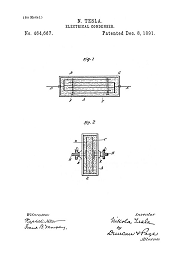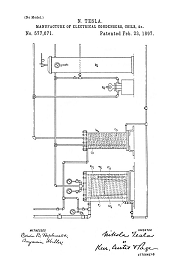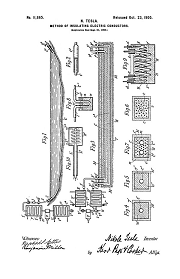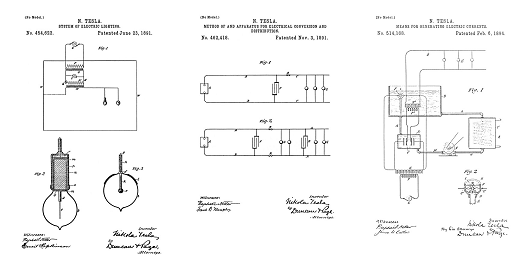Nikola Tesla's Oil Submersion Technology

Corona and Arc Suppression Using Liquid Insulators
Top: Early European Tesla Coil credited to Ducretet that was constructed following Tesla's lectures overseas and the publication of the 1891 lecture in French. T is an ordinary induction coil with a single layer secondary on a wooden spool, with the primary inside. It is submerged in a glass tank full of clear mineral oil. -- L is the Leyden jar, - "e" is the primary or "tank circuit" spark gap - and E are the output terminals with high frequency Tesla energy. Not shown is a low frequency conventional type high voltage induction coil used to charge the Leyden jar.
Stone Knives and Bear Skins - Spock, on YouTube
Tesla, and every single person who follows his work, encounters problems insulating conductors when his power processing technology is applied. Corona and sparks issue forth from the conductors when the circuits are operating correctly and everything is in tune. Another way to put this is, you know that you have a working circuit when the sparks that it produces, burns itself up. Self-destruction of the circuit is a sure indication that you are approaching success. Making Tesla technology bullet-proof reliable is an engineering challenge. First the circuits have to be carefully designed and laid out, using quality components throughout. Then the circuits must be carefully tuned and adjusted. When everything is perfect and correctly tuned, a circuit designed using materials available in the 1890's would promptly short out, and if the power is not cut off, they will catch fire and burn... Unless you do something to exclude the presence of air or other ionizing gasses. Wood is not an insulator unless it is soaked in oil, I have seen spark discharge from a Tesla coil pass right through dry pine as easily as it passes through air, and it illuminates the wood from the inside.
It may be found convenient to immerse the coil in paraffine oil or some other kind of oil; it is a most effective way of insulating, principally on account of the perfect exclusion of air, but it may be found that, after all, a vessel filled with oil is not a very convenient thing to handle in a laboratory. - N. Tesla, 1891 Lecture.
"When the frequency is increased beyond that rate, the potential, of course, rises, but the striking distance may, nevertheless, diminish, paradoxical as it may seem. As the potential rises the coil attains more and more the properties of a static machine until, finally, one may observe the beautiful phenomenon of the streaming discharge, Fig. 101, which may be produced across the whole length of the coil. At that stage streams begin to issue freely from all points and projections. These streams will also be seen to pass in abundance in the space between the primary and the insulating tube. When the potential is excessively high they will always appear; even if the frequency be low, and even if the primary be surrounded by as much as an inch of wax, hard rubber, glass, or any other insulating substance. This limits greatly the output of the coil, but I will later show how I have been able to overcome to a considerable extent this disadvantage in the ordinary coil." - Nikola Tesla, 1891 Lecture.

In 1892 Tesla demonstrated a coil designed and constructed to be submerged in oil.
"Curiously enough the sparks, when the terminals of the coil are set at a considerable distance, seem to dart in every possible direction as though the terminals were perfectly independent of each other. As the sparks would soon destroy the insulation it is necessary to prevent them. This is best done by immersing the coil in a good liquid insulator, such as boiled-out oil. Immersion in a liquid may be considered almost an absolute necessity for the continued and successful working of such a coil." - Nikola Tesla, 1892 Lecture
"The study of these discharge phenomena has led Mr. Tesla to the recognition of some important facts. It was found, as already stated, that gaseous matter must be most carefully excluded from any dielectric which is subjected to great, rapidly changing electrostatic stresses. Since it is difficult to exclude the gas perfectly when solid insulators are used, it is necessary to resort to liquid dielectrics. When a solid dielectric is used, it matters little how thick and how good it is; if air be present, streamers form, which gradually heat the dielectric and impair its insulating power, and the discharge finally breaks through. Under ordinary conditions the best insulators are those which possess the highest specific inductive capacity, but such insulators are not the best to employ when working with these high frequency currents, for in most cases the higher specific inductive capacity is rather a disadvantage. The prime quality of the insulating medium for these currents is continuity. For this reason principally it is necessary to employ liquid insulators, such as oils. If two metal plates, connected to the terminals of the coil, are immersed in oil and set a distance apart, the coil may be kept working for any length of time without a break occurring, or without the oil being warmed, but if air bubbles are introduced, they become luminous; the air molecules, by their impact against the oil, heat it, and after some time cause the insulation to give way. If, instead of the oil, a solid plate of the best dielectric, even several times thicker than the oil intervening between the metal plates, is inserted between the latter, the air having free access to the charged surfaces, the dielectric invariably is warmed and breaks down." - T.C.M. XXVII

In 1893, Tesla patented a unique oil driven Pelton wheel rotary switch as part of an electrical oscillator system in 514,168, Fig 2, above. The oscillator coils, capacitor, and the switch were all insulated in an oil bath with a cooling loop. The jet of oil driven by the pump powered the Pelton wheel switch, quenched the arc that forms on the switch contacts, and removes the heat. This combination greatly improves the reliability, efficiency, duty cycles, and service life of the circuit and the devices required for its operation. This circuit/machine was rated for continuous duty operation. It was drained of oil, packed up and shipped by rail, then refilled with oil and used for lecture demonstrations at the 1893 World's Fair - see Figure 311. The original machine was consumed by fire in 1895, and while it was photographed, only partial images and witness descriptions remain.
Overcoming the problems with ionizing gasses in proximity to conductors carrying Tesla energy resulted in several patents:
464,667

Electrical Condenser - Aug 1, 1891
"The exclusion of gaseous matter is not only desirable on account of the safety of the apparatus, but also on account of economy, especially in a condenser, in which considerable waste of power may occur merely owing to the presence of air, if the electric density on the charged surfaces is great." - T.C.M. XXVII
577,671

Manufacture of Electrical Condensers, Coils, & Etc. - Nov 5, 1896
"It has heretofore been shown by me that the efficiency and practicability of such devices are very greatly enhanced by the exclusion of air or gas from the dielectric separating the conductors or remote portions of the same conductor; and the object of my present improvement is to secure such exclusion of air in as perfect a manner as possible in a convenient and practicable way. To this end I place the condenser or other device to be treated in a receptacle from which the air may be more or less perfectly exhausted, and while in vacuum I introduce an insulating substance, which liquefies when subjected to heat, such as paraffin, which surrounds the said device and finds its way into its interstices. - N. Tesla, US Patent 577,671
11,865

Method of Insulating Electrical Conductors - Sept 21, 1900

The Tuve & Breit Tesla Coil, constructed in the 1920's for producing high-voltages used in particle accelerators was an oil submerged design. The coil as photographed was submerged in a tank with a sealed lid and pressurized with oil to squeeze out any air and prevent high-voltage breakdowns.
Tesla's Electrical Isochronous Oscillators

Capacitive Discharge Power Processing
The Inventions, Researches, and Writings of Nikola Tesla

The Martin Book
To the Archive Page Discussion on Tesla's Technology

